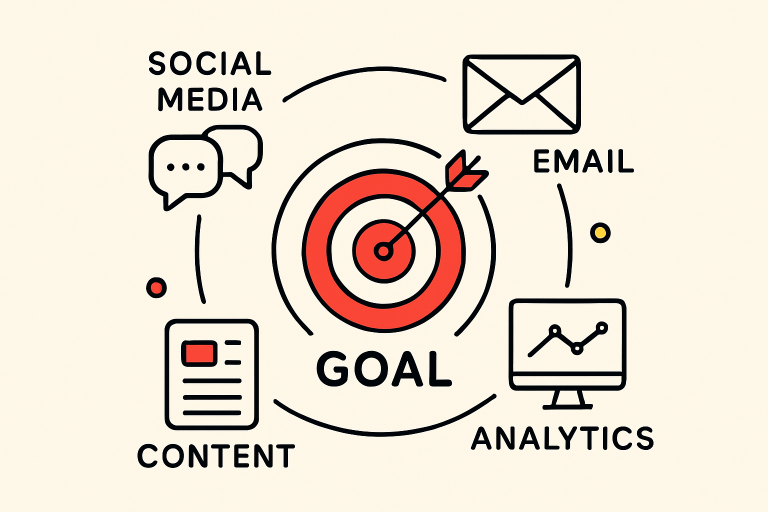Marketing
A Step-by-Step Guide to Implementing Full-Service Marketing Strategies
Table of Contents
- Introduction
- Define Your Business Goals
- Understand Your Target Audience
- Develop a Comprehensive Marketing Plan
- Leverage Technology and Data Analytics
- Implement and Monitor Your Strategy
- Adapt and Optimize
- Conclusion
Introduction
In an era of fierce competition and constant digital transformation, companies need a holistic approach to promotion that bridges all channels and tactics. Adopting a full service marketing agency approach allows organizations to weave together content, social tactics, analytics, and advertising under a unified strategy. With so many options available, knowing how to coordinate and implement a comprehensive marketing plan is more important than ever to achieve real business impact.
This step-by-step guide will walk you through building and implementing a full-service marketing strategy, from setting clear objectives to adapting your campaigns as the landscape evolves. By the end, you’ll understand how to create synergy across platforms, harness data-driven insights, and maximize returns with a streamlined, integrated approach.
Define Your Business Goals
Every effective marketing strategy starts with a strong foundation: clear, specific, and measurable business goals. Whether your focus is boosting brand awareness, driving qualified leads, increasing sales, or nurturing brand loyalty, defining these goals first is essential. According to Investopedia, marketing involves identifying, anticipating, and effectively satisfying customer needs, underscoring the importance of starting with precise objectives. Goals should be set using the SMART framework —specific, measurable, achievable, relevant, and time-bound—so every marketing initiative can be tracked and optimized for maximum impact.
Understand Your Target Audience
Deep audience understanding is central to success in full-service marketing. Start with robust market research using both qualitative and quantitative methods. Analyze current customers, survey prospects, and study competitors. Build detailed buyer personas that reflect demographic traits, preferences, challenges, and motivations. With this foundation, you’ll ensure every message resonates and every campaign reaches the people who matter most.
By shaping your strategy around your ideal audience, you’ll improve ROI and create more personalized, impactful marketing touchpoints. Such a data-driven approach enables you to map customer journeys, anticipate needs, and choose the best channels for engagement.

Develop a Comprehensive Marketing Plan
With goals defined and audience mapped, you’re ready to create a multifaceted marketing plan. Today’s most successful companies leverage several interconnected strategies:
- Content Marketing: Consistently produce valuable blog posts, infographics, videos, ebooks, or podcasts that answer your audience’s questions and establish authority in your niche.
- Social Media Marketing: Build relationships by sharing authentic, relevant updates on the platforms where your target audience is most active.
- Email Marketing: Segment your lists and personalize campaigns to nurture new leads, reengage dormant customers, and boost loyalty with timely, relevant messages.
- Search Engine Optimization (SEO): Ensure your web presence is optimized for search engines, from technical fundamentals to strategic keyword targeting and high-quality onsite content.
- Pay-Per-Click (PPC) Advertising: Achieve quick, measurable results with digital advertising on various platforms, consistently refining campaigns to reduce cost per acquisition and improve conversions.
A holistic approach weaves these tactics together—ensuring your organization is visible in organic search results, creates compelling content at every stage of the customer journey, and engages audiences again and again through coordinated cross-channel campaigns.
Leverage Technology and Data Analytics
To maximize returns and efficiency, leading marketing teams rely on a suite of technology tools—from content management systems and marketing automation platforms to CRM software and advanced analytics dashboards. Leveraging AI-powered insights and real-time data allows marketers to track user behavior, measure campaign performance, and make data-driven decisions with confidence. Utilizing robust analytics enables you to optimize spend, double down on what works, and quickly pivot away from underperforming tactics.
Implement and Monitor Your Strategy
Strategic execution is crucial. Roll out your campaigns across channels with consistency in branding and messaging. Employ project management tools to coordinate teams and workflows, keeping every stakeholder aligned. Track your results using key performance indicators (KPIs) like traffic, shares, click-through rates, cost per lead, and actual sales. Establish regular check-ins or dashboards to ensure ongoing visibility into what’s performing and where adjustments are needed.
Adapt and Optimize
Full-service marketing is never a “set it and forget it” proposition. Use your analytics and stakeholder feedback to refine your tactics continually. Stay on top of platform updates, evolving consumer behaviors, and emerging industry trends. Test new channels or formats as they arise, and be flexible enough to reallocate budget to where it will deliver the best results. By staying agile, your marketing will remain effective and competitive—no matter how the market shifts.
Conclusion
Implementing a modern, full-service marketing strategy gives organizations a framework for measurable growth and long-term brand visibility. By taking a structured, technology-driven approach—from defining goals to leveraging analytics and continually optimizing—you ensure your efforts are unified, strategic, and scalable. For organizations looking to rise above the noise and reach their true potential, adopting a full-service approach is not just an option; it’s a necessity.
